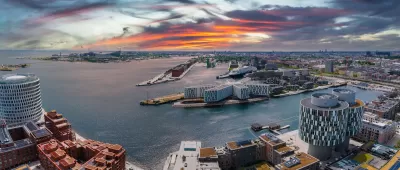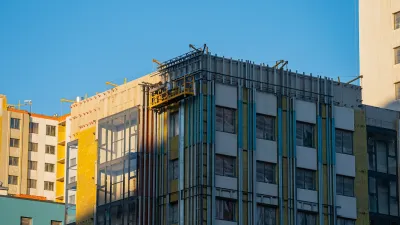Explore strategies for retrofitting old cities to enhance sustainability while preserving historical integrity and managing logistical challenges.

The effects of climate change are imminent, and cities are responsible for changing how they operate to improve their carbon footprints. However, city planners often face challenges in designing and executing sustainable retrofits while preserving their heritage.
Challenges in retrofitting old cities
Retrofitting initiatives often present challenges in cities.
Economic viability
Due to the complexity of the technologies, retrofitting a historic urban environment could be expensive. For example, to retrofit a permeable pavement, the original material will be removed, which means the city pays for the removal and installation costs. This is economically unattractive, especially since green methods mostly only show long-term cost-effectiveness and are subjective to the users.
Even with renewable energy retrofit in buildings, cost savings depend on residents' actions. A person setting the air conditioner temperature at 70 degrees Fahrenheit might see reduced energy bills faster than someone who sets it at 60 degrees F.
Heritage values
Many old cities are rife with buildings with historical and cultural significance. Retrofitting these could change their classic features, which many may consider disrespectful. For example, installing green windows may mean removing stained glass.
Implementing sustainable technology without compromising historical integrity requires awareness, expertise and efficiency. However, heritage quality and sustainability can sometimes be mutually exclusive, so planners might need to let go of one to prioritize the other.
Lack of awareness
Many still need to learn about modern sustainable technology. For example, in the U.K., almost 33.3% of people think gas is a form of green heating and 70% don’t know what heat pumps are.
This also contributes to a need for more experts in designing and implementing comprehensive and efficient urban retrofitting projects. In the U.S., 47 cities list green jobs without relevant strategies in their climate action plan. Some even omit the need for these jobs.
Another consequence of the lack of awareness is inadequate resources to execute these projects. Stakeholders generally don’t invest in these technologies because they don’t see the purpose and don’t engage in overcoming the hurdles of retrofitting old cities.
Effective ways to retrofit historic urban settings
Reimagining old cities for environmental sustainability may be complex, but it’s possible when done effectively. Here are some multi-pronged strategies to plan a historic urban retrofit.
Engage with stakeholders
Urban planners must ensure stakeholders are committed to improving the city’s sustainability. Educating them on the benefits of retrofitting to improve public health is necessary. For example, air pollution — a consequence of global warming — causes 7 million premature deaths yearly. Education could also lead to hiring more experts and investing in relevant technologies.
Research on suitable green technologies
Innovations are expanding in urban sustainability, and planners should research and choose the right technologies to match a city’s build and potential. These technologies should also not compromise the area's aesthetics and heritage value. One example is the automatic waste collection system, which reduces garbage trucks’ carbon footprint and keeps the building visually untouched.
Optimize costs
Retrofitting projects are costly, so planners must widen their options by researching financial opportunities such as green bonds, tax exemptions and government incentives like pollution-reduction subsidies in the U.S. Planners can also have investor talks to improve their risk perception and explain the long-term cost-effectiveness, like how energy efficiency contributes to a 12%-17% decrease in operating expenses.
Success stories of sustainable heritage cities
Many cities are moving toward a sustainable approach in their operations. An example is Copenhagen, Denmark — one of the world's most sustainable cities.
It has many retrofit projects, such as redesigning the Copenhagen Harbour into swimming pools and the district heating network in 2014. In addition, Tokyo, Japan, also prioritizes urban sustainability with a pledge to implement renewable power in buildings and use hydrogen produced by these energy sources for urban development.
Sustainability is the way forward for historic cities
Sustainability is crucial for cities to operate efficiently. To this end, stakeholders and urban planners must work together to balance heritage and green efforts.

Maui's Vacation Rental Debate Turns Ugly
Verbal attacks, misinformation campaigns and fistfights plague a high-stakes debate to convert thousands of vacation rentals into long-term housing.

Planetizen Federal Action Tracker
A weekly monitor of how Trump’s orders and actions are impacting planners and planning in America.

In Urban Planning, AI Prompting Could be the New Design Thinking
Creativity has long been key to great urban design. What if we see AI as our new creative partner?

San Francisco Mayor Backtracks on Homelessness Goal
Mayor Dan Lurie ran on a promise to build 1,500 additional shelter beds in the city, complete with supportive services. Now, his office says they are “shifting strategy” to focus on prevention and mental health treatment.

How Trump's HUD Budget Proposal Would Harm Homelessness Response
Experts say the change to the HUD budget would make it more difficult to identify people who are homeless and connect them with services, and to prevent homelessness.

The Vast Potential of the Right-of-Way
One writer argues that the space between two building faces is the most important element of the built environment.
Urban Design for Planners 1: Software Tools
This six-course series explores essential urban design concepts using open source software and equips planners with the tools they need to participate fully in the urban design process.
Planning for Universal Design
Learn the tools for implementing Universal Design in planning regulations.
Gallatin County Department of Planning & Community Development
Heyer Gruel & Associates PA
JM Goldson LLC
Mpact (founded as Rail~Volution)
City of Camden Redevelopment Agency
City of Astoria
Jefferson Parish Government
Camden Redevelopment Agency
City of Claremont






























